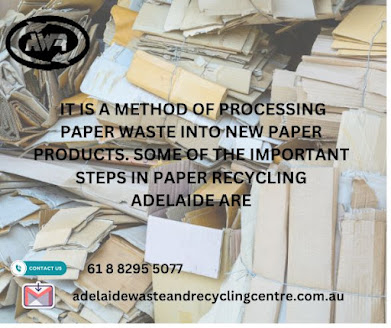Environmental and Economic Benefits of Paper Recycling
Introduction: One of the most popular and easily recycled materials
is paper, which is great for a variety of applications. For the packaging of
goods or the creation of new products, such as toilet paper, greeting cards,
wallpaper, and more, many companies employ recycled paper. The variety of
methods used to repurpose your discarded paper goods into new products might
surprise you. Let’s explore the common advantages of paper recycling in
Adelaide and why it is good for the environment and the economy.
Process of Paper Recycling
There is an intricate and interesting
process involved in paper
recycling in Adelaide and cards that are collected from households and
businesses:
Organising
Sorting is the initial step your spent
paper goes through when it gets to the paper mill. Depending on the kind, items
are separated and categorised, such as glossy paper, regular printer paper,
newspaper, etc. Because different types of paper require distinct handling
techniques, separation is necessary for effective recycling in Adelaide.
Pulping and Shredding
The process of shredding and pulping
starts once the paper has been sorted and cleaned of impurities. Before adding
water and other chemicals to further separate the fibres, the paper is torn
into minute pieces. The end product is mushy pulp, which is the starting point
for creating new items made from recycled paper. Before moving on to the next
step, the pulp is quickly cleaned to get rid of any non-paper objects like
staples and paper clips.
Remove Ink
To remove printing ink, glue residue,
and other adhesives, the pulp must be washed before de-inking. It could be
necessary to perform a further cleaning, known as the flotation procedure, for
some bigger and stickier particles. An air and surfactant-filled floating tank
is filled with the pulp. Everything, including the ink, sticks to the airborne
particles and rises to the top, where it is removed.
Bleaching
The pulp is either bleached or dyed to
give the paper the desired colour, depending on the finished product. Add
hydrogen peroxide, oxygen, or chlorine dioxide to create white paper. However,
the pulp isn't bleached when creating cardboard.
Rolling and Drying
The rolling and drying step is the last
one in the process of recycling in Adelaide
for paper. The pulp is heated and twisted into an enormous roll after being run
through big rollers to remove any remaining moisture. Then, these rolls—which
may be up to 30 feet wide and 20 tonnes heavy—are shipped to different
manufacturers so they can be used in their recycled paper goods.
Environmental Benefits of Paper
Recycling
Paper recycling in Adelaide at home or
work has several advantages for the environment. paper and cardboard can be
recycled, and doing so keeps waste out of landfills and keeps dangerous
greenhouse gases from entering the atmosphere. Recycling in Adelaide cuts
carbon dioxide emissions by about 20% when compared to cremation.
Paper recycling in Adelaide has several
benefits, one of which is that it requires less energy than producing new
goods. One tonne of recycled paper saves around 17 trees, 7,000 gallons of
water, 380 gallons of oil, 3.3 cubic yards of landfill space, and 4,000
kilowatt hours of electricity.
Economic Benefits of Paper Recycling
Paper recycling offers some financial
advantages in addition to lowering CO2 emissions, conserving energy and water,
and avoiding landfill space. Many local occupations in the paper recycling
business teach workers how to separate and sort paper waste and the industry is
growing.
Paper recycling guarantees that
contemporary businesses may easily meet their paper needs while reducing their
environmental impact. A company that has green credentials benefits from lower
environmental fines and taxes as well as improved customer perception, which
increases sales and profit margins.
Innovations in manufacturing and
technology have already benefited the paper recycling business, and this trend
is expected to continue. In addition, as scientists and engineers collaborate
to advance the sector, these discoveries open job prospects.
In summary
If you are wondering where to recycle
your paper or cardboard, you can contact the Adelaide Waste and Recycling
Centre (AWRC). As cardboard from both business and residential customers enters
the transfer station, their experts work diligently to separate recyclable
cardboard from general debris. Following its separation from other materials,
cardboard is transported in large quantities to a cardboard recycling facility,
where it undergoes processing to yield a clean, recycled product. They may also
provide cardboard recycling containers, with Solo Resource Recovery handling
scheduled, and frequent collections. By visiting your location to provide a
free evaluation, their specialists can customise a recycling collection service
to best meet your needs.




.jpg)
Comments
Post a Comment